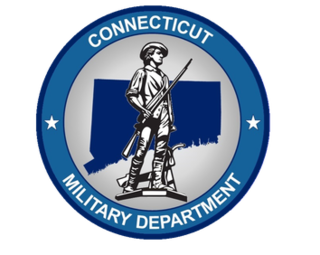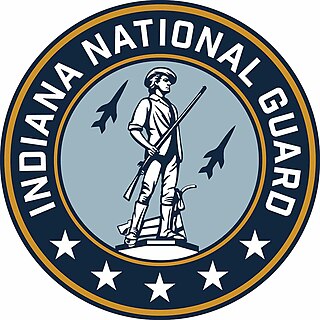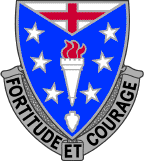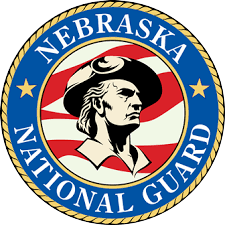
The Massachusetts National Guard is the National Guard component for the Commonwealth of Massachusetts. Founded as the Massachusetts Bay Colonial Militia on December 13, 1636, it contains the oldest units in the United States Army. What is today's Massachusetts National Guard evolved through many different forms. Originally founded as a defensive militia for Puritan colonists in the Massachusetts Bay Colony, the militia evolved into a highly organized and armed fighting force. The Massachusetts militia served as a central organ of the New England revolutionary fighting force during the early American Revolution and a major component in the Continental Army under George Washington.

The Connecticut Military Department is a state agency of the government of Connecticut. Its primary components are the Connecticut Army National Guard, the Connecticut Air National Guard, and four companies of the state militia. The Military Department of the State of Connecticut traces its origins to May 11, 1637, when the "General Courts" established a military arm of the provincial government. In 1939, the State's Military Department was established to consolidate the offices of Adjutant General, Quartermaster General, Armory Board, and Armory Board Inspector.

The Indiana National Guard (INNG) is a component of the United States Armed Forces, the United States National Guard and the Military Department of Indiana (MDI). It consists of the Indiana Army National Guard, the Indiana Air National Guard, and the Adjutant General's Office.

The 104th Infantry Regiment traces its history to 14 November 1639, when it was first mustered as the Springfield Train Band in Springfield, Massachusetts. In 1662 the unit was formed into the Hampshire Regiment of the Massachusetts Militia. It later served in the Continental Army during the American Revolution, with Union forces in the American Civil War, and as a federalized Massachusetts National Guard regiment with the U.S. Army during Spanish–American War, Mexican Border Campaign, World War I and World War II. The last active element of the regiment, the 1st Battalion, was deactivated in 2005 and the soldiers and lineage transferred to the 1st Battalion, 181st Infantry Regiment.
The 102nd Field Artillery Regiment is an inactive Field Artillery Regiment in the Massachusetts Army National Guard. Originally organized in 1786, the 102nd Field Artillery's predecessor units served in the Civil War, the Spanish–American War, and World War I. Units of the regiment served with the 26th Infantry Division during World War II and the Cold War.

The Nebraska Army National Guard is a group of Army National Guard units in the U.S. state of Nebraska. The Adjutant General for these units is Major General Craig W. Strong, who assumed his new duties in July 2023.

The Colonel Adelbert Mossman House is a historic house built between 1895 and 1903 located at 76 Park Street in Hudson, Massachusetts, United States. It is a 2+1⁄2-story wood-frame structure with asymmetrical massing typical of Queen Anne Victorian architecture. It has elaborate exterior and interior detailing. The house is listed on the National Register of Historic Places.

The 182nd Infantry Regiment is a regiment of the United States Army, forming part of the Massachusetts National Guard. It is among the oldest regiments in the U.S. Army, tracing its organizational roots back to 1636, and is one of several National Guard units with colonial roots and a campaign credit for the War of 1812.

The 181st Infantry Regiment shares the distinction of being the oldest combat regiment currently organized in the United States Army. It is one of several National Guard units with colonial roots and campaign credit for the War of 1812. The regiment traces its history to 13 December 1636, when it was one of four colonial regiments of foot of the British Crown in Massachusetts. It later served in the Continental Army during the American Revolution, with Union forces in the American Civil War, and as a federalized Massachusetts National Guard regiment with the U.S. Army during War with Spain, Mexican Border Campaign, World War I, and World War II. In 2006 Company A (Agawam) of the battalion deployed as a member of KFOR8 to Kosovo in support of Operation Joint Enterprise. Most recently the 1st Battalion, 181st Infantry has served in Iraq, in New Orleans following Hurricane Katrina, and in Afghanistan. The only active element of the regiment is the 1st Battalion, 181st Infantry Regiment, which returned from a year of service in Afghanistan in July 2011. The 1st Battalion was mobilized in March 2017 for one year of service with the Multinational Force & Observers in the Sinai Peninsula of Egypt. Currently, the 1st Battalion is a part of the 44th Infantry Brigade Combat Team, a major formation of the New Jersey National Guard. It was reflagged from the 50th Infantry Brigade Combat Team in 2017.

Headquarters Company, 1st Battalion, 181st Infantry is the command element for the 1st Battalion, 181st Infantry Regiment of the Massachusetts Army National Guard, stationed in Worcester, Massachusetts. The company perpetuates the Wellington Rifles, the historic volunteer militia company of Worcester. In the National Guard, companies sometimes have two histories. They share the history of the regiment to which they are assigned, but also may have a unique company history and lineage. Therefore, HHC 1-181 IN shares the long history of the 181st Infantry Regiment. While the 181st Infantry Regiment shares the distinction of being the oldest combat regiment in the United States Army, Headquarters Company was formed more recently during the volunteer militia craze of the 1890s. During this time young men began to flock to the independent militia companies forming in each town and city. These companies were both military units and social clubs. Headquarters Company has gone on to serve in the following conflicts: Spanish–American War, Mexican Border Campaign, World War I and World War II. Most recently the company served in Iraq, in New Orleans following Hurricane Katrina, and in Afghanistan.

Company A 1st Battalion 181st Infantry Regiment is the oldest active company in the 181st Infantry Regiment. In the National Guard, companies can share the history of the regiment to which they are assigned, but also may have additional unique company history and lineage. Company A traces its history to 1639, but also shares the history of the 104th Infantry Regiment and the 181st Infantry Regiment.

Company B 1st Battalion 181st Infantry Regiment is a rifle company in the 1st Battalion 181st Infantry Regiment. In the National Guard, companies sometimes have two histories. They share the history of the regiment to which they are assigned, but also may have a unique company history and lineage. Therefore, Company B 1-181 IN shares the long history of the 181st Infantry Regiment. This site concentrates on the unique history of Company B as a militia / National Guard company in Gardner and Greenfield, Massachusetts. Company B served in the Continental Army during the American Revolution, with Union forces in the American Civil War, and as a federalized Massachusetts National Guard regiment with the U.S. Army during the Spanish–American War, Mexican Border Campaign, World War I and World War II. Most recently the Company B has served in Guantanamo Bay Cuba, in New Orleans following Hurricane Katrina, and in Afghanistan. (See below for the separate history of Detachment I in Greenfield.

Company C, 1st Battalion, 181st Infantry Regiment is a rifle company in the 181st Infantry Regiment. In the National Guard, companies often have two histories. They share the history of the regiment to which they are assigned, but also may have a unique company history and lineage. Therefore, Company C 1-181 IN shares the long history of the 181st Infantry Regiment. This site concentrates on the unique history of Company C as a militia / National Guard company in Cambridge, Massachusetts. The company traces its history to 1831 when it was first mustered as the Cambridge Light Infantry. It later served with Union forces in the American Civil War, and as a federalized Massachusetts National Guard regiment with the U.S. Army during the Spanish–American War, Mexican Border Campaign, World War I and World War II. Most recently Company C has served in Bosnia, at Guantanamo Bay, Cuba, New Orleans following Hurricane Katrina, Iraq and Afghanistan.

Company D 1st Battalion 181st Infantry Regiment is a heavy weapons company in the 181st Infantry Regiment. It provides anti-armor and heavy machine gun support to the battalion operations. In the National Guard, companies sometimes have two histories. They share the history of the regiment to which they are assigned, but also may have a unique company history and lineage. Therefore, Company D 1-181 IN shares the long history of the 181st Infantry Regiment. This site concentrates on the unique history of Company D as a militia / National Guard company in Whitinsville, MA. The company traces its history to 1864 during the Civil War, when it was first mustered as the Company I, 5th Massachusetts Militia. It later served as a federalized Massachusetts National Guard regiment with the U.S. Army during the Spanish–American War, Mexican Border Campaign, World War I and World War II. Most recently the Company D has served in New Orleans following Hurricane Katrina, in Iraq and in Afghanistan.
Twenty-four current units of the Army National Guard perpetuate the lineages of militia units mustered into federal service during the War of 1812. Militia units from nine states that were part of the Union by the end of the War of 1812, plus the District of Columbia, are the predecessors of eighteen units that currently exist in the Army National Guard. Two of the four units derived from Virginia militias are in the West Virginia National Guard; at the time of the War of 1812, West Virginia was still part of Virginia. Only two current units, the 155th Infantry, a component of the Mississippi National Guard derived from militia units organized in the Mississippi Territory and the 130th Infantry, a component of the Illinois National Guard derived from militia units formed in the Illinois Territory, are from states or territories west of the Appalachians. Unfortunately, no militia units from the states of Kentucky, Louisiana, Ohio or Tennessee, or from the Indiana, Michigan, Missouri or Louisiana Territories, where militia units played a major role in the fighting, have survived as units in the modern Army National Guard.

"Fenway Company" the 1181st Forward Support Company is the forward support company (FSC) for the 1st Battalion, 181st Infantry Regiment. It provides transportation, maintenance and logistical support to the battalion operations. In the National Guard, companies sometimes have two histories. They share the history of the regiment to which they are assigned, but also have a unique company history and lineage. The 1181st FSC, for example, shares the history of the 181st Infantry Regiment. The company traces its history to the end of the Revolutionary War when it was first mustered as the 5th company of the 8th Regiment of Massachusetts Militia. It saw action in the Civil War as part of the 15th Massachusetts Infantry. It later served during the Spanish–American War, Mexican Border Campaign, World War I and World War II.

The 44th Infantry Brigade Combat Team is an infantry brigade combat team of the New Jersey National Guard. It is headquartered at the Lawrenceville Armory in Lawrenceville, New Jersey, United States. The 44th Infantry Brigade Combat Team is the major unit of the New Jersey Army National Guard. The 44th Infantry Brigade Combat Team has three light infantry battalions, a field artillery battalion, a cavalry squadron, an engineer battalion, and a support battalion.
The 2nd Massachusetts Volunteer Infantry Regiment was an infantry unit of the United States Army, mustered into Federal service during the Spanish–American War.

The 110th Cavalry is an inactive parent cavalry regiment of the United States Army National Guard. Constituted as the 26th Cavalry under the Combat Arms Regimental System in 1963, its 1st Squadron served with the 26th Infantry Division during the Cold War. It was renumbered in 1988 as the 110th and reorganized under the United States Army Regimental System in 1988 before the 1st Squadron inactivated in 1996 as a result of reductions in the National Guard after the end of the Cold War.










